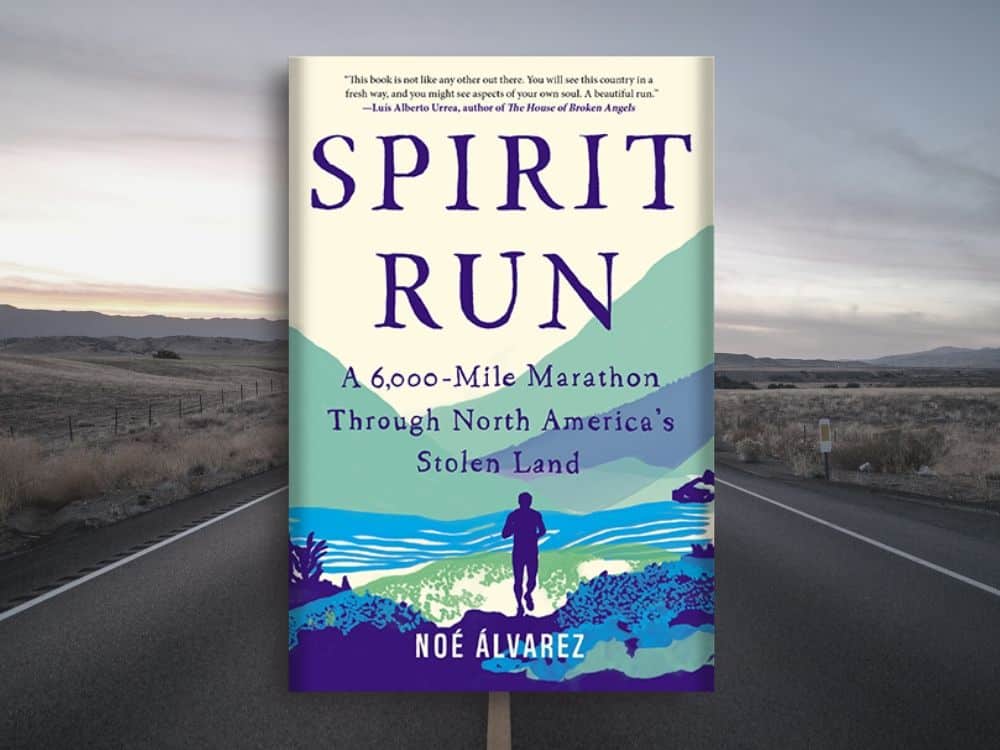Book Review | Spirit Run by Noé Álvarez
by Chase Parnell — April 15, 2020
Spirit Run: A 6,000-Mile Marathon Through North America’s Stolen Land is a memoir by Noé Álvarez. He grew up on the poor side of Yakima, Washington, a product of working class immigrant parents. With hard manual labor and the travails of the apple industry running through his veins, Noé persevered through circumstances that would’ve ruined your average kid.
Yakima, Washington
The descriptions of Yakima are the most vivid of the book. “Here, in this northeast part of town, where desert wildflowers consume rusted cars, rose bushes flourish near cornstalks, and broken glass from car thefts riddle the streets like mosaics, immigrants and working-class families live precariously, working hazardous jobs on uncertain legal statuses, doing their best to keep their teenagers safe from gang violence. Still, families push forward. They tend their many clucking chickens and jalapeño gardens; they hold barbecues, and play Mexican music, lending a hand, hammer, or wrench to anyone in need.” Are you not now amidst Yakima’s squalor?
It’s clear Noé’s parents worked an obscene amount; whether it was his mother in the apple processing plants, or his father in the orchards or on construction sites, they worked hard and yet didn’t exactly experience the American Dream as we know it. The Álvarez family spotlights what I think is a common misconception, that Mexican immigrants are riding the easy train just because they’ve made it to the USA. Noé pushes up against these themes when more than one of his characters questions whether this life of toil is in fact better than what they left behind in Mexico. The answer is unclear.
For me, Noé is telling the immigrant story in a wholly new way, one that hits close to home. I can’t picture my own mother in the context in which Noé found his, “…my jaws clench at the thought that my mother’s body is being molded by the demands of apple orchard owners. Her feet, shoulders, and hands seek relief from her sinking, stiff posture, her aches and misaligned joints. Blood queues in her calves in the form of varicose veins, and she shrugs at the pinch above her shoulders where the muscle has thickened like a bull’s hump.” I’ve considered the backbreaking work of field laborers on road trips all over the West. I’m 35 years old and can barely put the logs in our fireplace without tweaking my back, and yet hunched over and straining in awkward positions for hours on end is the norm for those who harvest and process our food.
I found Noé’s sweet relationship with his parents to be one of the most endearing elements of the book. He respects them and honors their way of life in his reflections, breathes life and understanding into their journeys, but it’s clear he wants more out of life than what they had, yet somehow he eloquently communicates this desire without disrespect or condescension.
Growing up privileged, I can’t possibly understand what it would be like to be so hungry that you’re forced to go out and search for food. Noé’s parents knew the pangs of hunger intimately and still suffer the after-effects. Noe’s mother constantly lamented the fact that Noé wasn’t chubbier, as if it were some sort of failing of hers. His Dad foraged his own food as a kid in Mexico, “This boy often canvassed the bush, high in the mountains, in search of things to eat, looking for help in a land that wouldn’t help him. He collected sapodilla chico fruit, captured birds and iguanas to take back to his family, and spent entire nights on the shores of the Pacific Ocean hours away in search of turtle eggs.”
Despite the inherent challenges Noé faced, he excelled educationally. He is anointed as gifted, a youth that could go out into the world and bring resources back to his people. Thus, the weight of the world is on his shoulders when he accepts a full-ride scholarship to Whitman College. It was a different environment as you can imagine, one he didn’t necessarily thrive in. The culture shock and social constructs were unbearable so he leaps at the opportunity to run away from it all to participate in what is termed a Peace and Dignity Journey — the Spirit Run.
North to South Trans-Continental Run
It’s not clear what initially planted the seed of running in Noé, but it’s clearly his therapy, his coping mechanism for a life such as his. “I have second-guessed myself every step of the way, becoming ashamed of who I am and who my parents are. Running helps vanquish these feelings. It reminds me that I have been telling myself the wrong story—that I don’t really belong, that we Latinos are an inferior people, that I am incapable of mastering the English language and moving confidently through the English-speaking world.”
It’s understandable then, that when life got hard, he’d be drawn to an opportunity that would essentially require him to run all day every day. From the informational pamphlet that piqued Noé’s interest: “Peace and Dignity Journeys occur every four years and start with Indigenous runners on opposite ends of the continents [Chickaloon, Alaska and Tierra del Fuego, Argentina]. They run for six months through hundreds of Indigenous communities where they participate in their respective spiritual practices and traditions; spark dialogue on the issue of peace and dignity for Indigenous peoples; model their responsibility to Mother Earth, Father Sky, communities, and themselves; and receive the community’s prayers. These prayers and conversations are then carried to proceeding communities until the runners reach the center of the hemisphere. When the runners meet at the Kuna Nation in Panama City, Panama, it will symbolize all Indigenous peoples joining together in a spiritual way to manifest the prophecy of the Eagle and Condor.”
Noé identifies as Mexican-American but his paternal grandfather was of Purépecha indigenous descent from the southern mountains of Michoacán. Noé was conflicted and feared what dropping out of college might do to his parents, “But on the run is where I need to be. Out there, fully immersed in a new kind of chaos, in the wild, alongside Native runners, and relearning to be myself. A place where I can learn to be a better and a stronger son to my parents, a journey where I can push myself to the limit and begin to approach the pain of migration. I want to honor my parents’ journey to the United States by embarking on my own adventure, and run on my own terms.”
Noé goes and exhibits great courage in doing so. He’s greeted by a complicated set of native personalities; not exactly welcomed with open arms. He was tested, even abused, and his motivations for joining the Spirit Run were constantly questioned.
The reader gets to know the cast of characters well; their stories unfathomable: products of gang violence, young pregnancies, dead parents, eco-activism, suicidal tendencies, and emotional and historical trauma. Mazat, Zyanya Lonewolf, Cheeto, Pacquiao, Andrec, Chula Pepper, Tlaloc, Crow, Ipana, Refugio, and Trigger were their names, all with a tale of suffering that goes back generations. Each longing to return to a world of peace and dignity, still trying to reconcile how they fit in this world of colonialism, displacement, and reservations.
The physical toll was heavy; Noé slept in a tent, often ran up to 30 miles a day, and was constantly dehydrated and malnourished. It was his swollen fluid-filled knees that would ultimately end his run.
As with any great adventure, Noé earns a smattering of tales he’s sure to tell until he’s old and gray: he learns the age of his death from a palm-reading mystic in Eugene, Oregon, which cracked me up because that is my hometown; of course that happened. He has a terrifying encounter with a cougar, he gets lost while running through Los Angeles, he is force-fed peyote when his knees inflame into the size of cantaloups, he wakes one morning to a back covered in blisters from cricket urine, and decides he must abandon the run in Guatemala before reaching the terminus in Panama. In short, he lived.
Relentless Forward Progress
Noé ends his debut memoir by describing the job he had while writing this book: a security officer at the oldest library in the United States, the Boston Athenæum. Walking the library’s halls in a suit and tie he detests, he fully acknowledges that he has yet to figure out this life, but he’s diligent in moving towards answers. “Here, I contend not only with the mental fatigue of museum silence, but the nervous reality that has haunted and pestered me all of my life: that I will always be working-class.” You can exchange the term working-class with any other categorization that haunts you and find solace in Noé’s journey.
Disclaimer: If you purchase this book through the links below, Treeline Journal will earn a small commission. Thank you for your support!
Buy on Bookshop.org | Compassionate Choice — Supports Local Bookshops
Buy on Amazon | Convenient & Cheaper Choice — Supports Jeff Bezos |

We Need Your Help.
If you enjoyed this book review, consider supporting Treeline Journal through Patreon for as little as $2 a month. Every little bit goes a long way!


